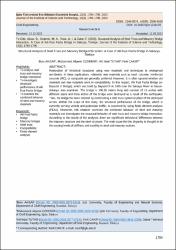| dc.contributor.author | Akşar, Bora | en_US |
| dc.contributor.author | Özdemir, Muhammed Alperen | en_US |
| dc.contributor.author | Tutar, Ali İkbal | en_US |
| dc.contributor.author | Çakır, Ferit | en_US |
| dc.date.accessioned | 2023-10-16T19:30:29Z | |
| dc.date.available | 2023-10-16T19:30:29Z | |
| dc.date.issued | 2023-10-02 | |
| dc.identifier.citation | Akşar, B., Özdemir, M. A., Tutar, A. İ. & Çakır, F. (2023). Structural analysis of steel truss and masonry bridge interaction: a case of Ali Fuat Pasha bridge in Sakarya, Türkiye. Iğdır Üniversitesi Fen Bilimleri Enstitüsü Dergisi, 13(3), 1784-1798. doi:10.21597/jist.1218178 | en_US |
| dc.identifier.issn | 2146-0574 | en_US |
| dc.identifier.issn | 2536-4618 | en_US |
| dc.identifier.uri | https://hdl.handle.net/11729/5758 | |
| dc.identifier.uri | http://dx.doi.org/10.21597/jist.1218178 | |
| dc.description.abstract | Restoration of historical structures using new materials and techniques is widespread worldwide. In these applications, relatively new materials such as steel, concrete, reinforced concrete (RC), or composite are generally preferred. However, it is often ignored whether old materials and new materials work in compatibility. In this respect, Ali Fuat Pasha Bridge (or Bayezid II Bridge), which was built by Bayezid II in 1495 over the Sakarya River in Geyve-Sakarya, was examined. The bridge is 196.50 meters long and consists of 15 arches with different spans and three arches of the bridge were destroyed as a result of the earthquake. Then, the bridge has been restored by constructing a steel truss system in place of the destroyed arches. Within the scope of this study, the structural performance of the bridge, which is currently serving vehicle and pedestrian traffic, is examined by using finite element analyses (FEAs). Moreover, this research examines the combined behavior of steel and masonry materials and investigates the structural behavior of steel truss and masonry bridge interaction. According to the results of the analyses, there are significant behavioral differences between the masonry structure and the steel structure. The main cause for this disparity is thought to be the varying levels of stiffness and ductility in steel and masonry sections. | en_US |
| dc.language.iso | en | en_US |
| dc.relation.ispartof | Iğdır Üniversitesi Fen Bilimleri Enstitüsü Dergisi | en_US |
| dc.rights | info:eu-repo/semantics/openAccess | en_US |
| dc.subject | Ali Fuat Pasha Bridge | en_US |
| dc.subject | Masonry structures | en_US |
| dc.subject | Steel truss | en_US |
| dc.subject | Compatibility | en_US |
| dc.subject | Restoration | en_US |
| dc.subject | Finite element analyses | en_US |
| dc.title | Structural analysis of steel truss and masonry bridge interaction: a case of Ali Fuat Pasha bridge in Sakarya, Türkiye | en_US |
| dc.type | Article | en_US |
| dc.description.version | Publisher's Version | en_US |
| dc.department | Işık Üniversitesi, Mühendislik ve Doğa Bilimleri Fakültesi, İnşaat Mühendisliği Bölümü | en_US |
| dc.department | Işık University, Faculty of Engineering and Natural Sciences, Department of Civil Engineering | en_US |
| dc.authorid | 0000-0002-9972-5516 | |
| dc.authorid | 0000-0002-9972-5516 | en_US |
| dc.identifier.volume | 13 | |
| dc.identifier.issue | 3 | |
| dc.identifier.startpage | 1784 | |
| dc.identifier.endpage | 1798 | |
| dc.peerreviewed | Yes | en_US |
| dc.publicationstatus | Published | en_US |
| dc.relation.publicationcategory | Makale - Uluslararası Hakemli Dergi - Kurum Öğretim Elemanı | en_US |
| dc.institutionauthor | Akşar, Bora | en_US |
| dc.indekslendigikaynak | TR-Dizin | en_US |


















